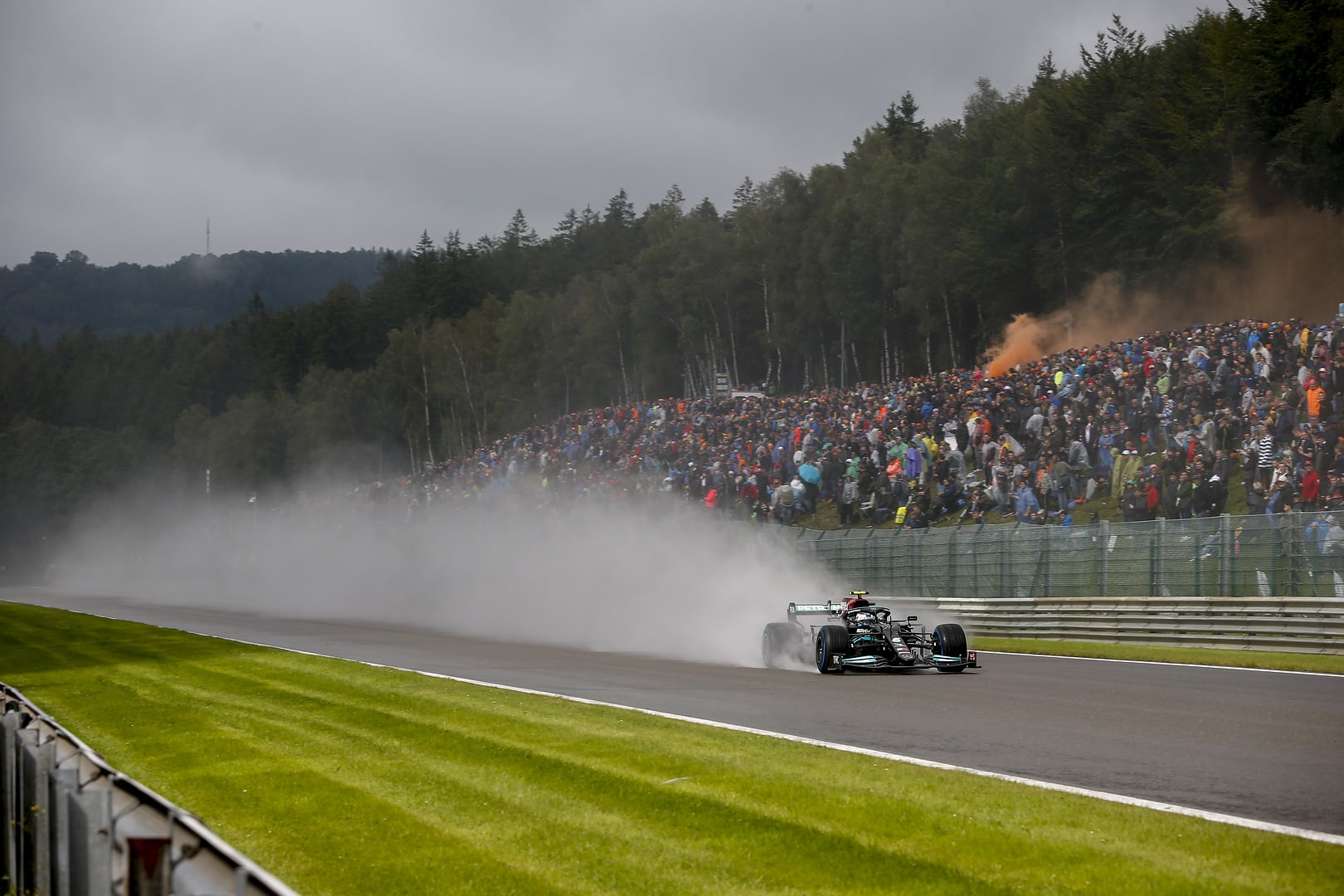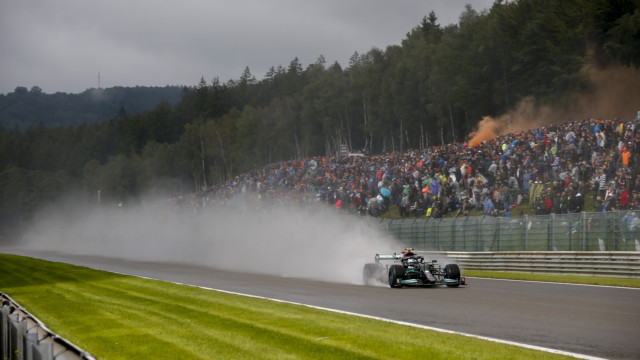What Impact Does The Weather Have On F1?


Ahead of F1’s return to Montreal, Mercedes’ latest feature asks what impact does the weather have on F1? – the cars, the drivers and the engineers…
What Impact Does The Weather Have On F1?
What role do temperatures at the racetrack play in F1?
Formula One drivers must race in a wide range of track and weather conditions over the course of a season no matter whether it’s hot, cold, day, or night, and in all conditions in between. Temperatures both on and around the track also have a particularly important role to play.
“Track temperatures can drastically affect tyres,” says George Russell. “When you’re driving on a track that’s nice and cool, the tyres cool down pretty much every time you race down the straight. But on the other hand, when the track is scorching hot, you are basically driving on top of a saucepan, heating up the tyres, so they don’t afford you as much grip.”
Sunlight has a direct influence. Track temperatures dip when the sky is cloudy even if it’s still quite hot, and as you would expect, temperatures tend to be much lower during night races than in the daytime. The colour of the tarmac also plays an important role.
“You can see that some tracks are a bit greyer than others that are literally black,” says George. “And of course, that attracts the heat and sends temperatures climbing, which then always makes things a bit harder on tyres. So there’s a direct correlation between track and tyre temperatures, but ambient temperatures can also affect a whole lot of other things.”
Of course, it’s not just the tyres that are impacted by heat. The drivers have to race, whatever the temperature, and the car components are also impacted when temperatures change.
How great an effect do temperatures have on F1 performance and setup?
Ambient temperatures can majorly impact a car’s performance. Ideally, the temperatures of individual components should be just on the limit when drivers are pushing and getting the maximum out of the car. However, achieving that is no easy task.
The unproblematic way would be to simply maximize the car’s cooling and make its ducts as big as possible. That would reduce stresses on vehicle components, but at the same time, would also have a harmful effect on aerodynamic performance, since airflow is not only used for cooling, but also to generate downforce efficiently.
“It depends on the situation you find yourself in,” says George. “Sometimes, in a perfect scenario, everything is on the limit. There’s nothing to manage and you can drive at full throttle, but when you’ve got too big a cooling effect, then quite often, you’re not optimising aerodynamic performance. You just can’t have maximum cooling for the brakes and Power Unit, because that then means you need plenty of big, fat bodywork to really cool things down, which costs performance. You have to find the right balance.”
What effect do temperatures have on Formula 1 car technology?
At Montreal’s Circuit Gilles-Villeneuve, keeping the car cool plays a vitally important role. It gets quite hot there sometimes, which can be a significant challenge as far as engines are concerned, but this track has always been a real test of brakes and braking systems ever since its inception.
Teams try not to let brakes cool down too much, as that can affect the car’s aerodynamics, meaning it loses performance. And at the same time, the many long straights where cars reach extremely high top speeds combined with the slow corners mean that brakes can get heavily stressed.
What effect do temperatures have on an F1 driver in the cockpit?
Another aspect of cooling has to do with the driver himself. These days, drivers have to endure incredibly cramped conditions in their cockpits due to the limited space around them, and they also have a huge number of heat-emitting boxes of electronics and pipes to contend with.
Once again, teams don’t want to use too much airflow for cooling as that might affect other aspects of performance, but of course, they also have to consider the limits of human endurance at certain races. The intense heat during some races can become a major source of distraction for drivers in the cockpit as they push themselves to the limit both mentally and physically. Obviously, if they get too hot, they can’t concentrate fully on getting the best out of the car.
What changes for F1 drivers in the wet?
Rain-affected races pose another big challenge for drivers. Visibility is much poorer, and you can get standing water at certain parts of the circuit or may even find water running in rivulets down the track, making it incredibly slippery and unpredictable. “It’s very easy to make a mistake in the wet,” says George.
However, that’s not the only difficulty that drivers face, as rain seldom falls in the course of a Formula One season. “You don’t get that many laps and that much experience in the wet,” says George. “We probably do 95 percent of the season in the dry and only 5 percent in the wet when conditions are always variable. It might rain a little more or a little less, while in the dry, things remain pretty much the same. So, you have to be on your toes and be very dynamic and adaptable in the rain.”
Some drivers like wet conditions more than others, but every driver has his preferred set of conditions. As George goes on to tell us: “The perfect weather conditions don’t exist as far as drivers are concerned. The conditions that exist on the day when you are fastest are the perfect ones, whether it’s hot and sunny, or dry and cold with a bit of fog thrown in. Ultimately, conditions are only perfect when you win.”
How do F1 teams decide when it’s the perfect time to switch from intermediates to slicks?
One of the questions that most frequently arises on a rain-hit race day is when is the right time to switch from Intermediates to slicks. It’s one of the tensest moments for the team, but also incredibly exciting, and can be the difference between victory or defeat. So it’s vital the strategists, engineers and drivers all work closely together.
“When it’s inter conditions going to slicks, i.e. onto a dry tyre,” says George. “We racing drivers tend to take the same line and that’s when the track dries up. It may be dry on 75 percent of the track, but if a quarter of the circuit is still very, very wet and you are on dry tyres, you probably won’t even be able to make the turn. So it’s very tricky, you may need slicks on half of the track or three quarters of it, but it’s the wettest point on the circuit that dictates when to switch.”
And who gets to decide at what point to change from Intermediates to slicks? Well, that depends entirely on how the race is going. When a team has nothing to lose, they will try to be very aggressive in making the call to change over, but the driver knows how it feels out on track and when it is safe to make the switch.
And on the other hand, if there is something to lose, like the race lead, you’re less likely to be the first to take the risk. This is when the strategy team can have more input, because they often have much more information at their fingertips, such as GPS and lap time data, compared to the driver, which is why they are there to guide him at such tricky moments in time.
Watch: What Impact Does the Weather Have on F1?
The video ‘What Impact Does the Weather Have on F1?’ features interviews with Mercedes staff Rosie Wait (Head of Race Strategy), Rich Lane (Senior Track Engineer) and George Russell (Driver of Car No. 63).
Information for this post was provided to the media by Mercedes-AMG Petronas F1 Team.





